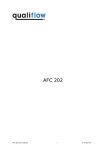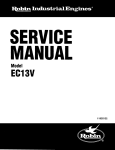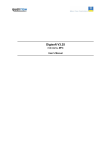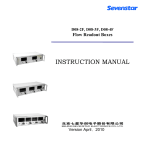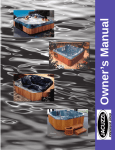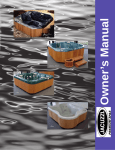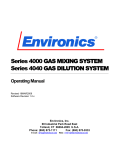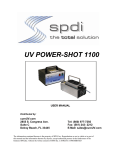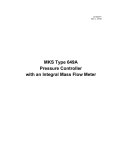Download AFC 202D - MHz Electronics, Inc
Transcript
AFC 202D AFC 202 D User’s Manual 1 D 10-018 V04 QUALIFLOW Montpellier (headquaters) 350, rue A. Nobel BP7- 34935 MONTPELLIER CEDEX 9 France tel: +33 4 67 99 47 47 fax: +33 4 67 99 47 48 QUALIFLOW Inc, 24 Goose Lane TOLLAND CT-06084 CALIFORNIA - USA tel: +1 860.871.04.01 fax: +1 860.871.92.33 QUALIFLOW Technical Center 909 Boggs Terrace Fremont, CA-94539 CALIFORNIA - USA tel: +1 510 440 93 74 fax: +1 510 440 93 75 QUALIFLOW Japan 3F Hattori Bldg., 4-30-14, Yotsuya, Shinjuku-ku Tokyo 160-0004 Japan Tel: +81 (0)3 5366 2801 Fax: +81 (0)3 3341 3513 AFC 202 D User’s Manual 2 D 10-018 V04 Reference D-10-018 Document Name File Name Author Visa Date Olivier Léonel 03/07/02 Author Olivier Léonel Olivier Léonel Olivier Léonel Olivier Léonel Date 17/11/00 18/01/01 26/02/01 03/07/02 Identification Revision 04 User's Manual AFC 202D AFC202D Manual.doc Control Verified Visa Date Didier Stupfler 03/07/02 History Description Initial Version Exploded View added New section layout Specification update Date 03/07/02 Approved Visa Date P. Garnier 03/07/02 Revision 00 01 03 04 Status Issued Issued Issued Issued 2002 QUALIFLOW Montpellier, France. This document contains information proprietary to QUALIFLOW and shall not be used for engineering, design, procurement or manufacture in whole or in part without consent of QUALIFLOW. AFC 202 D User’s Manual 3 D 10-018 V04 SECTION 1 - INTRODUCTION .............................................................................................. 5 1.0 AFC 202.D: DIGITAL MASS FLOW CONTROLLER .............................................. 5 1.1 AFC 202.D : "USER's MANUAL" .............................................................................. 5 1.2 SPECIFICATIONS....................................................................................................... 6 1.3 CALIBRATION FEATURES ...................................................................................... 7 SECTION 2 - INSTALLATION................................................................................................ 8 2.0 INTRODUCTION ........................................................................................................ 8 2.1 UNPACKING ............................................................................................................... 8 2.2 MECHANICAL INSTALLATION.............................................................................. 8 2.3 ELECTRICAL INSTALLATION .............................................................................. 10 2.4 CHECKS BEFORE STARTING UP.......................................................................... 12 2.5 DIGITAL CARD. ....................................................................................................... 12 2.6 COMMUNICATION MODES................................................................................... 16 SECTION 3 – MAINTENANCE............................................................................................. 17 3.0 GENERAL ..................................................................................................................... 17 3.1 DISASSEMBLY AND ASSEMBLY PROCEDURES ................................................. 17 3.2 SENSOR CLEANING AND REPLACEMENT ........................................................... 20 3.3 VALVE CLEANING AND REPLACEMENT ............................................................. 20 SECTION 4 – TROUBLESHOOTING ................................................................................... 21 4.0 INITIAL CHECK. ...................................................................................................... 21 4.1 SYMPTOMS............................................................................................................... 21 SECTION 5 - WARRANTY AND SERVICES ...................................................................... 23 5.0 PRODUCT WARRANTY.......................................................................................... 23 5.1 SERVICES.................................................................................................................. 24 APPENDIX A GAS PROCESS NUMBER.......................................................................... 25 APPENDIX B EXPLODED VIEW OF THE AFC 202D .................................................... 26 APPENDIX C GENERAL MFC PRINCIPLES ................................................................... 28 AFC 202 D User’s Manual 4 D 10-018 V04 SECTION 1 - INTRODUCTION 1.0 AFC 202.D: DIGITAL MASS FLOW CONTROLLER The QUALIFLOW Digital Mass Flow Controller AFC202.D offers the highest degree of accuracy and reliability in controlling high gas flows. This range has been designed specifically to prevent contamination and particle deposition. It is therefore ideal when using in semiconductor and optical fiber manufacturing processes. It takes benefit from the digital technology : new features such as alarm and maintenance functions are available (with the free QUALIFLOW’s PC interface digisoft). With a specially developed algorithm, the regulation is obtained without overshoot and during the transient time, the readout matches the real flow. 1.1 AFC 202.D : "USER's MANUAL" This manual includes the following sections : Section 1. Introduction : contains specifications and calibration features. Section 2. Installation : contains all the information necessary to unpack the AFC202.D without causing contamination, install the AFC202.D and check the installation before starting up. All data related to digital card and use of a PC with RS232 connection are developed. Section 3.Maintenance. Section 4.Trouble-shooting. AFC 202 D User’s Manual 5 D 10-018 V04 1.2 SPECIFICATIONS AFC 202.D Flow Range From 30 slm to 400 slm N2 Control Range Between 2 and 100% F.S Valve type Electromagnetic Valve Rest position Normally Open or Close ± 1% of setpoint if setpoint > 30% of F.S. ± 0.3% of F.S. Accuracy if setpoint < 30% of F.S. Linearity ± 0.2% F.S (per cal Gas) Repeatability ± 0.15% F.S Step Response Time <= 2.5 sec (SEMI E17-91 Temperature Range Between 5 and 50°C Temperature Coefficient < 0.05% F.S /°C Maximum Inlet Pressure 10 bar Min. Differential Pressure 1.5 bar for 30 slm 2 bar for 50 slm 2.5 bar for 100 slm 3 bar for 200 slm 4.5 bar for 400 slm Pressure Coefficient < 0.1% F.S /bar Power Input Requirement + 15 VDC –15V ; 600mA Set Point Signal From 0 to 5 VDC Flow Outpout Signal From 0 to 5 VDC Electrical Connector Sub-D 15 Construction materials Leak integrity 316L stainless Steel < 2.10-8 sccm/sec (He) Standard Seals 316L Stainless Steel Seals on request Neoprene for NH3 Viton for other gases Fittings On request Options Kalrez seals Separated electronics Device Net or PROFIBUS RS 485/MODBUS AFC 202 D User’s Manual 6 D 10-018 V04 1.3 CALIBRATION FEATURES The Mass Flow Controllers are calibrated close to customer’s process. Without customer’s information, the MFCs are calibrated under standard conditions. 1.3.0 STANDARD CONDITIONS Without special conditions specified by the customer, the MFC is calibrated under the following standard conditions : Pressure conditions : Pressure Outlet : Atmospheric Delta Pressure : between 500 mbars and 3 bars Dynamic adjustment : no overshoot The mounting position (horizontal, vertical inlet up or down) should be specified by the customer to ensure the best accuracy . 1.3.1 MANUFACTURING ENVIRONMENT The MFCs are assembled, calibrated, packaged and controlled in a class 100 cleanroom. 1.3.2 QUALITY CONTROL Each MFC is controlled 24 hours after manufacturing on a different calibration bench. The accuracy, the dynamic response, the stability to pressure variations are double checked. AFC 202 D User’s Manual 7 D 10-018 V04 SECTION 2 - INSTALLATION 2.0 INTRODUCTION This four part section contains all the information necessary to install the AFC202.D mass flow controllers. • 2.1 - UNPACKING; • 2.2 - MECHANICAL INSTALLATION; • 2.3 - ELECTRICAL INSTALLATION; • 2.4 - CHECK BEFORE START UP. • 2.5 - DIGITAL CARD. • 2.6 - COMMUNICATION MODES. 2.1 UNPACKING The AFC202.D mass flow controller are manufactured under clean room conditions, and has been packed accordingly upon receipt. The cardboard packing should be checked for damage. If there is visible damage, please notify your local QUALIFLOW sales office at once. In order to minimize contamination of clean rooms, the unit has been packed in two separately sealed plastic bags. The outside bag should be removed in the entrance to the clean room. The second bag should be removed when you install the unit. 2.2 MECHANICAL INSTALLATION 2.2.0 GENERAL Most applications will require a positive shutoff valve in line with the mass flow controller. Pressurized gas trapped between the two devices can cause surge effects, and consideration must be given to the sitting of the shutoff valve (upstream or downstream) in relation to the process sequencing. As far as the process parameters will allow this, it is recommended that you install an in-line filter upstream to the controller in order to prevent from contamination. The AFC202.D can be mounted in any position. The atmosphere should be clean and dry. The mounting should be free from shock or vibration. Mounting dimensions are shown in figure 2-1. Prior to installation, ensure that all the piping is thoroughly cleaned and dried. Do not remove the protective end caps until you are ready to install the controller. AFC 202 D User’s Manual 8 D 10-018 V04 15 pin D AFC 202D MASS FLOW CONTROLLER 182 QUALIFLOW http://www.qualiflow.com 20 B A 24 30 30 45 4 holes M5 Figure 2-1 Dimensions (mm) A (mm) B (mm) AFC 202 VCR 3/8” MM Swagelok 3/8 181,4 183,3 (incl. nuts) 123 123 AFM 302 VCR 3/8” MM Swagelok 141.9 143.8 (incl. nuts) 83.5 83.5 2.2.1 INSTALLATION WARNING: Toxic, corrosive or explosive gases must be handled with extreme care. After installing the mass flow controller, the system should be thoroughly checked to ensure it is leak-free. Purge the mass flow controller with a dry inert gas for one hour before using corrosive gases. IMPORTANT: When installing the mass flow controller, ensure that the arrow on the back of the unit shows the same direction as the gas-flow. 2.2.1.1. VCR COMPATIBLE COUPLINGS The AFC50.MD mass flow controller is normally supplied with 1/4" male VCR compatible couplings on both sides. To install the AFC, follow the steps listed below. Refer to figure 2-2. 1. 2. 3. 4. 5. Check the gland to gland space, including the gaskets. Remove the plastic gland protector caps. a) When using loose VCR "original" style gaskets, insert the gasket into the female nut. b) For VCR retainer gaskets, snap the gasket onto the male coupling. See figure 2-2. Tighten the nuts finger tight. Scribe both nut and body in order to mark the position of the nut. AFC 202 D User’s Manual 9 D 10-018 V04 6. While holding the body with a wrench, tighten the nut : 1/8 turn past finger tight for 316L stainless steel and nickel gaskets. VCR original style gasket VCR retainer gasket Figure 2-2 VCR compatible couplings 2.3 ELECTRICAL INSTALLATION 2.3.0 GENERAL Within this section, you will find the following sub-sections: • Connections. • Digital functions. • Pressure control. • Ratio control. • Communication plug. 2.3.1 CONNECTIONS The electrical connections of the AFC202.D are made through a sub D 15 connector (see figure 2-3). RS 232 adapters for use in maintenance functions are available (model 4). Digital’s card sub D 15 connector : 9. Signal Com 10. Power Com 11. RS232 Tx 12. Valve voltage 13. TTL2 14. GND 15. TTL3 1. Signal Com 2. Readout 3. TTL1 4. RS232 GND 5. +15 VDC 6. -15 VDC 7. RS232 Rx 8. Setpoint Figure 2-3 Pin arrangement for digital Card connector. Dedicated interface connector is available to allow digital MFC connection to work with other pin arrangement, according to figure 2.4. This second pin arrangement is compatible with the AFC 202 D User’s Manual 10 D 10-018 V04 AFC 202 analog QUALIFLOW Mass Flow Controller. A card edge adapters coupled with a RS232 cable is available. The card edge connection is widespread in the industry. 9. Setpoint 10. Power Com 11. Signal Com 12. Test Softstart 13. Zero command 14. -15 VDC 15. Not used 1. Case GND 2. Signal Com 3. Readout 4. +15 VDC 5. Zero test 6. +5 VDC 7. Valve voltage 8. Extra output Figure 2-4 Adapters pin arrangement (compatible with QUALIFLOW’s analog AFC 202) MODEL 1 D Sub 15 pin Male RS232C D Sub 9 pin Female MODEL 4 D Sub 15 pin Male Card-edge 20 pin RS232C D Sub 9 pin Female D Sub 15 pin Female D Sub 15 pin Female MODEL 2 MODEL 3 D Sub 15 pin Female D Sub 15 pin Female Card-edge 20 pin Connectors Conversion Adapters QUALIFLOW MFC / Connector Replaced MFC / Connector Analog AFC50/AFM D Sub 15 Main MFC’s Card-edge 55 pin Digital All Series D Sub 15 Main MFC’s Card-edge pin Digital All Series D Sub 15 Analog AFC50/AFM D Sub 15 pin 55 pin Digital All Series D Sub 15 Main MFC’s D Sub 15 pin pin 0-5V to 4-20mA Conversion Adapters MFC Type QUALIFLOW Analog AFC50/AFM55 QUALIFLOW Digital and Main MFC’s with D Sub 15 pin connector AFC 202 D User’s Manual 11 Model Part Number 1 Q201733-01 1 2 3 4 4 Q201733-07 Q201733-08 Q201733-09 Q201733-10 Q201733-06 Model 3 3 Part Number Q201733-05 Q201733-15 D 10-018 V04 Other Accessories Part Number Q 2001733-12 Control and Power Supply Kit for QUALIFLOW Digital MFC’s all series : When connecting individually a Digital MFC to a computer use this interface kit, which includes: • Connector conversion adapter, P/N q 2001733-06 • Power supply assy 120/230 VAC, ±15VDC, P/N Q2001733-14 • Power cord from power supply to MFC, length 1 meter, P/N Q2001733-13 • RS232C cord from MFC to computer, length 2 meters, P/N Q2001733-11 2990924Q Connecting cord for Analog AFC50/AFM55 or digital MFC’s all series : • D Sub 15 pin female connector (MFC side), wires ready to weld at the other end • Length 5 meters 2.4 CHECKS BEFORE STARTING UP Before operating the mass flow controller the following checks should be completed : 1. Check that tubing is leak proof. 2. Check the process sequence and proper function of all other gas components involved. 3. Check the voltage of command signals and power supply to the mass flow controller. 4. Check that the appropriate gas type is being supplied at the rated pressure. 5. Allow the mass flow controller to warm up for 20 minutes, then check the zero level output. 6. Use dry inert gas for test runs. 7. Prior to using the mass flow controller for extremely corrosive gases, purge with a dry inert gas for one hour. 2.5 DIGITAL CARD. 2.5.0 INTRODUCTION QUALIFLOW has designed and developed a digital card for its Mass Flow Controllers (MFC) that take advantages of the full potential of digital technology. Not only enabling digital communication, these cards improve MFC accuracy and control using a numerical control algorithm. They store several calibration curves, therefore QUALIFLOW customers can reduce the number of references that they use. They also make maintenance operations easier : through alarm functions and PC diagnostic via RS232. The development of the digital technology has brought great improvements in : • Accuracy • Control • Additional capabilities This new digital card is 100% compatible with previous QUALIFLOW analog Mass Flow Controllers. However the digital mode is best used for maintenance functions or in calibration mode. The RS485 communication and the device net communication allow the use in digital communication mode with standard industry protocol. 2.5.1 A BETTER ACCURACY All analog MFC's are calibrated with potentiometers at three points : 2%, 50% and 100% FS to make the error at 0%, 25%, 50%, 75% under 1% FS. The numerical MFC's are calibrated at more than 6 points and the response curve is then calculated. Their accuracy is ± 1% of AFC 202 D User’s Manual 12 D 10-018 V04 setpoint if setpoint > 30% of F.S., ± 0.3% of F.S. if setpoint < 30% of F.S. So the linearity is much better at small setpoints (see the following graph). Most of digital MFCs use linear interpolation to calculate the response curve whereas the QUALIFLOW digital board achieved better accuracy, with lower calibration points thank to polynomial interpolation. The RS232 or RS485 or Device net connection let you to change the calibration curve by choosing the corresponding number without disconnecting the MFC. 10 calibration curves can be stored in memory. To maintain the best accuracy the maximum factor between two full scales of two several calibrations is 3. The set point and the measure are converted by 16 bits CAN for the best accuracy. The analog readout is converted by 12 bits CNA which does not alter the accuracy of the flow. 2.5.2 AN OPTIMIZED NUMERICAL CONTROL The control of the gas flow is made by a numerical algorithm which assumes a control without overshoot at any set point. Each calibration curve is stored with its own optimised regulation parameters which are determined by calculation. An analog control is fixed by the electronic components and can not be adapted to each gas and to each full scale. For example, an analog regulation can not avoid overshoot at low flow rates whereas an algorithm gives fine control at any set point. The following typical curves compare the analog regulation with the numerical one. As the response time of the digital MFC's are more repeatable and do not depend on electronic components. So digital MFC's have closer transient behaviours, which brings a great improvement in process with mixed gases. AFC 202 D User’s Manual 13 D 10-018 V04 2.5.3 RAMPING The ramping function increases linearly the set point in order to give a progressive raise in the flow. It could be used to keep stoechiometric values during transient response of a process. The increase of the set point by unit time is chosen by the user (see software manual). 2.5.4 SOFT-START The soft start function closes the valve if the set point is lower than 1%F.S. For a new set point greater than 1%F.S, the regulation starts after a delay that is chosen by the user. This way you can avoid big overshoots caused by pressure drop, when starting a process. AFC 202 D User’s Manual 14 D 10-018 V04 2.5.6 IN SITU CALIBRATION The calibration can be automatically made by calibration devices with a serial communication. The calibration is made with six points without potentiometers. The QUALIFLOW software allows to calibrate the MFC from the ‘Molblox’ device (Caltechnics). 2.5.7 AUTO-ZERO The function AUTO-ZERO corrects the drift of the MFC. It can be done automatically or by the user. The correction can not exceed 0.5%. 2.5.8 ADDITIONAL CAPABILITIES Additional capabilities are customized by a free PC Interface (see the software’s manual in the CD). 2.5.8.0 LED INDICATOR The MFC contains three LEDS located on the left hand side. The left LED is the watchdog LED. When blinking, it indicates whether the MFC is on power or not. A quick blinking (several times per second) indicates that the MFC is working on a analog mode. The second LED indicates whether the regulation is obtained (switched on) or not (switched off). Switched on, the third LED indicates an error as : a sensor error a communication error a EEPROM error a valve type error a converter (A/D) error 2.5.8.1 ADJUSTABLE ALARM The user chooses three parameters, the delta min, the delta max and the delay alarm, in order to adjust the regulation alarm. Delta min and delta max (in ‰ FS) are the maximum differences between the readout and the set point to get before the delay time. If the MFC AFC 202 D User’s Manual 15 D 10-018 V04 does not correctly control, the alarm is on until the user switches it off. For example, if the pressure is too low, the MFC could not regulate the flow The alarm signal will be generated until the user switches it off. This alarm can be switched off by soft . 2.5.8.2 TOTALIZER The totalizer indicates the cumulative flow in % FS since the last initialisation. It is useful to have a look on your gas consumption. 2.5.8.3 DATA STORING / RETRIEVING The set point, the valve voltage and the readout are stored at a frequency of 2 times a minute during 6 hours and can be saved as an excel file. These data allow the diagnostic of sensor drift or pressure drop. For example an increasing in valve voltage for the same set point could be due to contamination or corrosion. Data can be scanned and retrieved at any time without interruption while the MFC runs in control mode. 2.6 COMMUNICATION MODES. In addition to the ability to use this digital MFC on analog mode with the advantage of communication via serial RS-232C for maintenance, calibration or individual control (DB 15 connector, following options are available : RS-485 option: can control up to 32 MFC's under MODBUS protocol (RJ11 connector). DeviceNet or PROFIBUS option: this mode allows communication with high speed protocol. For more information during utilization, contact QUALIFLOW, France. AFC 202 D User’s Manual 16 D 10-018 V04 SECTION 3 – MAINTENANCE 3.0 GENERAL No routine maintenance is required on the meters or controllers, other than occasional cleaning and re-calibration : After 3 or 4 years when the unit is run with a ultra-clean and non corrosive gas. After 1 or 2 years when the unit is run with a low purity gas and/or a corrosive gas. Cleaning can be performed by removing the unit from the system, cleaning inlet and outletfittings separately and pumping alternately reverse and forward for 5 minutes in each direction with a solvent system (one micron maximum absolute filtration). Next, the unit must be blown with N2 for 30 minutes minimum. Reinstall cleaned fittings. In extreme cases of contamination, it may be necessary to separately clean the sensor, the bypass and the valve. 3.1 DISASSEMBLY AND ASSEMBLY PROCEDURES If you disassemble the mass flow controller, it will need recalibration in order to reach the specifications given in this manual. If the mass flow controller appears to have a fault, first perform the checks in the troubleshooting section, as it may not be necessary to dismantle the valve. Prior to disassembly, make sure the unit has been purged with a dry inert gas. WARNING : if it becomes necessary to remove the controller from the system after exposure to toxic, pyrophoric, flammable or corrosive gas, purge the controller thoroughly with a dry inert gas such as nitrogen, before disconnecting the gas connections. Failure to purge the controller could cause a fire or explosion reasulting in death. CAUTION : the electronic circuitry contains CMOS and NMOS components. These are easily damaged by static electricity, and usual precautions should be taken when installing, dismantling or adjusting the mass flow controller. 3.1.0 DISASSEMBLY PROCEDURE 0. Remove any mounting plate that may be under the mass-flow. 1. Unscrew in- and outlet-fittings 7 and 8 with a 1" wrench. 2. Unscrew 14 and remove the cover 19. 3. Remove the sensor-screws 15 with a 2.5mm hex screw driver, after having the lead wires unsoldered from the p.c. board. Handle the sensor 2 with care. 4. Remove the screw 33 in the bottom of the valve. 5. Unsolder the magnet actuator wire from the pc board, then remove the 4 screws which hold the magnet to valve body. Then carefully lift the magnet. Do not turn the mass-flow controller now. 6. Carefully remove the top housing 24 with the bellows and plunger assembly from the valve housing 23. Then carefully unscrew the lower bellow. 7. Remove the 4 screws 9 in the top of the top housing 24 which hold the top ring assy 29. Then remove the bushing 32. AFC 202 D User’s Manual 17 D 10-018 V04 Note: If o-rings are dirty, cut or cracked, they have to be exchanged with appropriate new, clean ones. 3.1.1 ASSEMBLY PROCEDURE First mount sensor, inlet and outlet fittings. Caution : The sensor capillary sometimes extends beyond the seals o-rings. When positioned on the base without verifying that capillary ends fit in the holes in the base, the capillary can be bend or damaged. Therefore, center the sensor by means of the mounting screws, hold it up and then fasten the screws. Normally open valve 1. Check the quality of the contact between 3/8" ball and its seat on top housing 24. Both parts should be polished without any scratch. 2. Place upper bellow 40 in top housing 24. 3. Select number of washers M3, crown spring 30 and ball, so that the end of the stem of the upper bellow assy is 1 to 1.5 mm below top surface of the top housing (with ball on the seat). 4. Select now place of the crown spring between the washers so that when the crown spring is on its seat, the ball is lifted halfway the space adjusted in step 3 (0.5 to 0.75 mm). Note : keep ball, washers and crown spring together with nut M3. 5. Now, lengthen carefully the upper bellow so that it just contact the crown spring. 6. Mounting assy in top housing. 7. Place spring 6 over the upper bellow. Add spring adjustment ring 31 and screw these over half way the thread length. 8. Place the O-ring over the upper bellow and put in place in the top. Caution : The O-ring must be very clean ( clean with alcohol if necessary) without any scratch. Same think for its chamber in the top housing. If not, very small leak may occur and with time full the top housing with high pressure with consequence that the valve will stay permanently in open position. 9. Place bushing 32, top ring 29 and the 4 M3 screws 9, do not yet tighten. 10. Preparing lower bellow assy : Be assured there is no gap between bellow and and the part screw at the bottom. Unscrew and counter sunk the bellow part as necessary. 11. Now, screw and tighten the lower bellow to the stem, coming out the top housing (remove first the M3 nut putted during step 4). 12. Press on the stem, so to center the ball into the seat, then tighten the 4 screws 9. Tight the screws together in order to keep the inner assy in its centered position. 13. Adjust the lower bellow length at 47.5mm as when it will be mounted into the housing 23 it should not be compressed or extended. 14. Assemble top housing 24 to the housing 23 with O-ring 37 on bellow assy and O-rings 36 and 38 on top housing but without magnet in place for first leak test of the O-ring 26. AFC 202 D User’s Manual 18 D 10-018 V04 15. Assemble top housing now with O-rings 36 and with magnet in place. 16. Adjust valve according the normally open valve adjustment procedure then test the valve. 17. Do final leak test Normally close valve 18. Check the quality of the contact between 3/8" ball and its seat on top housing 24A. Both parts should be polished without any scratch. 19. Place upper bellow 40 in top housing 24A and adjust bellow by pulling or pushing so that the top of the upper bellow stem 40 is adjusted to the top of the housing 24A. 20. Remove upper bellow 40. 21. Place washers M3 27 over stem and place crown spring 30. Add washers that crown spring 30 just touches the bottom of the bellow assy (+/- 0.5 mm). ( Normal value : 3 washers of 0.8 mm ). 22. Place the assy 40 (up side down) in top housing 24 and put on solid surface (seat up). Now place ball over the stem from 40 with ball O-ring grove faced to the seat. Look for contacting ball to seat. And measure the exposed end of M3 from the stem (length is A). 23. Disassemble again. Place now the ball 29 over the stem (same way as above) and screw a M3 nut on the stem. Adjust nut to the same dimension as A. 24. Measure space B between crown spring and ball. Disassemble ball and nut M3. 25. Prepare a package of small washes M3 27 to a thickness B. (Normal value : 6 washers of 0.8 mm. May be necessary to put 5 0.8mm + 1 0.5mm or 5 0.8mm + 2 0.5mm). 26. Mounting assy in top housing. 27. Place spring 6 over the upper bellow. Add spring adjustment ring 31, screw these over half way the thread length. 28. Place the O-ring 26 over the upper bellow and put in place in the top housing. Caution : The O-ring 26 must be very clean ( clean with alcohol if necessary) without any scratch. Same think for its chamber in the top housing. If not, very small leak may occur and with time full the top housing with high pressure with consequence that the valve will stay permanently in open position. 12. Place package washers B, O ring 28 and the ball over the stem and place M 3 nut to prevent dropping of the parts. 13. Place bushing 32, topring assy 29 and the 4 M3 screws 9, do not yet tight. 14. Preparing lower bellow assy: Be assured there is no gap between bellow and the part screwed at the bottom. Unscrew and counter sunk the bellow part as necessary. 15. Now, screw and tighten the lower bellow to the stem, coming out the top housing (remove first the M3 nut putted during step 12). 16. Adjust the lower bellow at 47.5mm as when it will be mounted into the housing 23 it should not be compressed or extended. AFC 202 D User’s Manual 19 D 10-018 V04 17. Assemble top housing to the housing 23 with O-ring 27 on bellow assy and O-rings 36, 38 but without magnet in place for first leak test of O-ring 26. Do not forget the snap ring on the top of the upper bellow stem 40. 18. Assemble top housing with magnet in place. Do not Install the O-rings 36 with inert gas. 19. Test valve. 20. Do final leak test. Note : For leak testing of the AFC 202 normally close it is necessary to put power on it to open the valve or pumping down from inlet and outlet side at the same time. 3.2 SENSOR CLEANING AND REPLACEMENT If it is determined that the sensor is contaminated, flush with a solvent in hypodermic needle, while running a small wire (0.15 mm diameter, available on request). Do not immerse the entire sensor assembly in a solvent; the solvent will keep under the cover and destroy or at least change the sensor characteristics. Slow dry with nitrogen. If the sensor resistance has changed or even open circuit is measured, the assembly should be replaced. The measured resistance between red and green (R1) and between red and yellow (R2) must be between 160 and 190 Ω and ΩR = R2-R1 must be less than ±1 Ω. Check also that there is no short-circuit between the tube and the red wire. Examine the sensor seals, and replace when damaged. 3.3 VALVE CLEANING AND REPLACEMENT After having disassembly the valve, the status of the shut-off ball and the seat in the top housing can be examined. The shut-off ball can be cleaned with alcohol, freon or even a HF solution (5% HF, 95% deionised water). The conical seat and the ball can be treated with solvent and a felt tip. If appropriate polishing equipment is available, the seat and shut-off ball can be polished. After polishing, the parts must be cleaned. If the critical parts are unfortunately corroded or attacked too much, replace. Afterwards, follow assembling instruction and adjustment instruction. AFC 202 D User’s Manual 20 D 10-018 V04 SECTION 4 – TROUBLESHOOTING 4.0 INITIAL CHECK. 1. Check the gas supply pressure and check that the flow-path to the mass flow controller has been opened. 2. Ensure that the power supply and command signals are correctly transmitted to the D-connector pins on the PC-board. 3. Check that the output signal matches the external reading. For pin assignments see figure 2-3. Use the following table to locate the fault. 4.1 SYMPTOMS. Problem 1: Output reading, without gas flow, is not zero. Possible cause Action 1. Gas flow is actually present 2. Zero reading has drift less than 1.5% Check closure of series shutoff valve. Try ‘Autozero function’ by the software Problem 2: Zero reading cannot be adjusted by autozero. Possible cause Action Defective sensor. Check that sensor voltage between red and orange wires is equal to the voltage between red and blue wires. Both must be 4 to 6 volts. Contact QUALIFLOW for advice. If defective, the controller may need replacing. Problem 3: Valve will not close Possible cause Action 1. Check the Mfc is properly connected on the gas line 2. Set-point is not zero 3. Incorrect solder pad connections 4. The Mfc is in digital mode and you use it with a set-point voltage 5. The parameters min valve (for a NC) is too high The parameters max valve (for a No) is too low 6. Incorrect actuator voltage Disconnect the MFC after following the procedure Check set-point voltage on PC-board pin 9 See the strap configuration Change the control mode by the software 7. Incorrect nozzle adjustment 8. Plunger stuck AFC 202 D User’s Manual Increase or decrease one parameter by the software of this Voltage across actuator wires must be : between 0V and 30V Remove mass flow controller and readjust nozzle. Remove controller and clean up. 21 D 10-018 V04 Problem 4: Controller will not open to full scale flow Possible cause Action 1. Check the Mfc is connected in the good way on the gas line 2. Incorrect setpoint on PC-board (pin 8) 3. Incorrect supply pressure Disconnect the MFC after following the procedure Check setpoint voltage. Check gas pressure at inlet side of mass flow controller 4. The Mfc is in digital mode and you use it with Change the control mode by the software a set-point voltage 5. Incorrect flow reading Check the numerical readout found by the software is correct 6. Incorrect solder pad connections Check the strap configuration 7. The parameters max valve (for a NC) is too Increase or decrease one of this low parameter by the software The parameters min valve (for a No) is too high 8. Incorrect actuator voltage Voltage across actuator wires must be :between 0V and 30V Problem 5: Unstable control Possible cause Action 1.Unstable pressure 2. Defective electronics Check inlet and outlet pressure stability Replace mass flow controller and contact QUALIFLOW for advice. Contact QUALIFLOW Contact QUALIFLOW 3. Bad Regulation parameters 4. Defective Mechanics For any other problems, contact QUALIFLOW. AFC 202 D User’s Manual 22 D 10-018 V04 SECTION 5 - WARRANTY AND SERVICES 5.0 PRODUCT WARRANTY 1. Qualiflow products are guaranteed against defects in materials and workmanship if used in accordance with specifications and not subject to physical damage, contamination, alteration or retrofit. Warranty periods (from the date of shipment) are the following : AFC90MD series 3 years AFC80MD, AFC310MD series 2 years INFLUX, AFC50, AFC202, AFC260 & AFC261 series 1 year 2. Buyers undertake to check and inspect the goods and to notify Qualiflow of shipment incidents by fax, phone or e-mail as soon as possible after receipting the goods. 3. During the warranty period, products must only be repaired by authorized Qualiflow service centers; otherwise, the Qualiflow product warranty will be invalidated. 4. Repairs will be performed free of charge during the one-year warranty period. If MFCs are out of warranty, Qualiflow will notify the owner of replacement or repair costs before proceeding. Factory service and repairs are guaranteed 90 days. The warranty excludes consumable materials and wear parts (in teflon, viton, etc.). 5. No MFC will be accepted for repair or warranty without a decontamination and purge certificate. 6. Each MFC is individually checked (visual inspection of fittings, helium leak test and flow calibration). Qualiflow shall not be responsible for any damage caused by gas leakage or the use of a dangerous gas. Users are responsible for following the safety rules applicable to each gas they use. Improper use of a Qualiflow MFC will void the warranty, and MFCs that have been damaged as a result of improper use will not be replaced by Qualiflow. 7. Specific warranty requirements are as follows : a. Gas must be clean and particle-free, which means a filter must be fitted in the gas line upstream of the MFC. b. Gas must comply with the following pressure specifications: i. Gas pressure must never exceed 10 bars. ii. Differential pressure must be more than 500 mbar for full-scale flow through the MFC valve unless an other value is specified in the user’s manual. iii. Differential pressure must be less than 3 bars for the MFC valve to regulate without gas-flow oscillation unless an other value is specified in the user’s manual. iv. Pressure at the mass-flow inlet must be regulated by an accurate pressure regulator to prevent gas-flow oscillation. c. Electrical connection requirements are as follows: i. The system must be wired carefully: non-observance of the pinout may irreversibly damage the electronic board inside the MFC, in which case the warranty will be invalidated. ii. A stable power supply is required, with ripple below 5mV. AFC 202 D User’s Manual 23 D 10-018 V04 d. Gas connections: the fittings must be handled carefully. Qualiflow guarantees that all fittings have been individually inspected and are scratch-free. e. Fitting procedure: the fitting procedure set out in the manual must be followed meticulously. Specifically, the purge procedure is very important if corrosive gases or toxic gases are used. f. The mass-flow must not be dismounted: the MFC warranty will be invalidated if the seal between the MFC block and cover is torn. 5.1 SERVICES QUALIFLOW Products Engineers will help you to solve your problems regarding operation, calibration, connection, gas flows, gas mixture, etc. We deliver technical support or maintenance within 24 hours. QUALIFLOW offers factory training on mass flow controllers. Visit www.qualiflow.com and find your nearest repair and calibration center. Hotline : +33 (0)4 67 99 84 31 AFC 202 D User’s Manual 24 D 10-018 V04 APPENDIX A GAS PROCESS NUMBER Symbol Gas Name Number NH3 Ar AsH3 BCl3 CO CCl4 Cl2 B2H6 SiH2Cl2 CHF3 CCl2F2 CF4 GeH4 He H2 HCl C2F6 Kr CH4 CH3SiCl3 N2 NO2 NF3 N2O O2 O3 PH3 C3H8 SiH4 SiF4 Si2H6 SO2 SF6 TiCl4 C4F8 SiHCl3 Air Ammonia Argon Arsine Boron Trichloride Carbon Monoxide Carbon Tetrafluoride Chlorine Dibirane Dichlorosilane Fluoroform Freon-12 Freon-14 Germane Helium Hydrogen Hydrogen Chloride Hexafluoroethane Krypton Methane Methyltrichlorosilane Nitrogen Nitrogen Dioxide Nitrogen Trifluoride Nitrous Oxide Oxygen Ozone Phosphine Propane Silane Silicon Tetrafluoride Disilane Sulphur Dioxide Sulphur Hexafluoride Titanium Tetrachloride Octafluorocyclodutane Trichlorosilane 008 029 004 035 070 009 101 019 058 067 049 084 063 043 001 007 011 118 005 028 183 013 026 053 027 015 030 031 089 039 088 097 032 110 114 129 147 AFC 202 D User’s Manual 25 Density SEMI E520298 1.2929 0.7710 1.7842 3.481 5.26 1.2500 6.86 3.209 1.24 4.54 3.125 5.5 3.96 3.423 0.1788 0.0899 1.635 6.16 3.73 0.7166 6.670 1.2503 6.675 3.173 1.98 1.429 Sp. Heat C [ cal/g/°C ] 0.2401 0.519 0.1246 0.1178 0.130 0.495 0.141 0.116 0.495 0.141 0.173 0.149 0.167 0.138 1.242 3.400 0.1937 0.185 0.0596 0.528 0.164 0.2484 0.194 0.178 0.206 0.2183 1.000 0.68 1.453 0.666 0.40 1.000 0.309 0.83 0.44 0.43 0.506 0.34 0.41 0.58 1.454 1.016 0.981 0.24 1.45 0.722 0.250 1.000 0.41 0.434 0.206 0.996 1.523 1.98 1.438 4.68 0.2607 0.392 0.3188 0.168 0.688 0.35 0.596 0.35 2.91 6.5 8.465 0.149 0.1590 0.22 0.67 0.27 0.30 6.047 0.130 0.348 D 10-018 V04 APPENDIX B EXPLODED VIEW OF THE AFC 202D AFC 202 D User’s Manual 26 D 10-018 V04 Item 1 2 3 4 5 6 7 7A 8 8A 9 10 10A 11 12 13 14 15 16 17 18 19 20 21 22 23 24 24 A 25 25A 26 27 28 29 30 31 32 33 34 35 36 36A 37 38 39 40 41 AFC 202 D User’s Manual qty 1 1 1 1 1 1 1 1 1 1 1 1 1 1 2 1 2 2 1 2 4 1 1 1 1 1 1 1 1 1 1 x 1 1 1 1 1 1 1 4 2 0 1 1 4 1 4 Description High flow meter base Sensor Assy P.C. Assy Plate print Bypass assy Spring Intlet fitting 3/8" sw Intlet fitting 3/8" VCR Outlet fitting 3/8" sw Outlet fitting 3/8" VCR Screw M3x8 hex head Fitting plate assy AFM 302 sw Fitting plate assy AFM 302 VCR O-ring 25x2 (Viton) O-ring 910 (Viton) Sensor seal (Viton) Screws M3x16 pan head Screws M3x10 Hex head Screws M3x5 pan head Screws M4x10 hex head Screws M5x10 hex head cover Sticker name plate Sticker gas range & S/N Sticker pin assignment Valve housing 1 Valve top housing Normaly.Open. Valve top housing Normaly.Close. Magnet actuator Normaly.Open. Magnet actuator Normaly.Close. O-ring 20x2 Viton Adjustment washer M3 O-ring 3x1 viton Assy top ring Crown spring Spring adjustment ring Bushing 1 Screw M3x5 pan head Oring 25x2 viton screw M5x50 hex head Oring 37x2 viton Do not use on normaly close. Oring 904 viton Oring 16x2 viton Threated rod M5x120 Assy inner valve 202 nut M5 27 PN 580812011.11 997200000 Q5180001.**.04. 580812062.11 280812030.00 800100204 2055880-02 2055880-01 500210005 800211203 808092028 580212030.11 580213020.11 580810230.11 580810180.11 580810180.21 500600001.NO 500600001.NC 808092043 808092040 580810200.11.assy 580810040.11 580810190.11 580810210.11 808092044 808092045 808092031 808122001 717Q001.**.02 580810240.00 D 10-018 V04 APPENDIX C GENERAL MFC PRINCIPLES Mass Flow Controllers (MFCs) are used wherever accurate measurement and control of a mass flow of gas is required independently of flow pressure change and temperature change in a given range. Mass Flow Meters (MFMs) are used wherever accurate measurement of gas is required without control of the flow which is done by another device. To help understand how an MFC works, it can be separated into 4 main components: a bypass, a sensor, an electronic board and a regulating valve : The bypass, the sensor, and one part of the electronic board are the measurement side of the mass-flow controller and makes a Mass Flow Meter. The regulating valve and the other part of the electronic board are the controlling side of the mass-flow controller and exist only on a Mass-Flow Controller. So every Mass-Flow Controller includes a Mass-Flow Meter. MEASUREMENT PRINCIPLES The flow is divided between a heated sensing tube (the sensor), where the mass flow is actually measured, and a flow restriction or bypass, where the majority of flow passes. The bypass is designed in a way that flow thru the sensor and thru the bypass is always proportional to the flow range for which the mass-flow is build. The sensor is designed to deliver an output voltage almost proportional to the gas flow circulating thru it which is due to the bypass design proportional to the total flow circulating thru the mass-flow meter or controller. The electronics board amplifies and linearizes the sensor signal so the output of the electronics board named “readout” gives a signal proportional to the total flow circulating thru the mass-flow meter or controller. Most of the time this signal is a 0-5 V voltage signal. 0 means “no flow” and 5 V means Full scale of the mass-flow. The full scale is the maximum flow for which the mass-flow is designed and calibrated to work with a good accuracy. It is always written on the stickers which are on the top of the cover and the side of the massflow stainless steel base. Also written on the sticker is the gas for which the mass-flow is calibrated to work with. AFC 202 D User’s Manual 28 D 10-018 V04 Why using a bypass ? Because the sensor element can only measure small flow (typically 5 sccm). So the bypass allow to measure greater amount of flow. On a 5 sccm full scale massflow, there is no bypass, all the gas flows thru the sensor. On a 100 sccm full scale massflow, the bypass is adjusted as when 100 sccm flow thru the mass-flow 5 sccm will flow thru the sensor and 95 sccm will flow thru the bypass. SENSORS PRINCIPLES Basically, the sensor uses the thermal properties of a gas to directly measure the mass flow rate. The sensor uses the basic principle that each gas molecule has a specific ability to pick up heat. This property, called the "specific heat" (Cp), directly relates to the mass and physical structure of the molecule and can be determined experimentally. The specific heat is well known for many gases and is generally insensitive to changes in temperature or pressure. By adding heat to a gas and monitoring the change in temperature, the mass flow rate can be determined. To illustrate this concept, take the case of cool gas flowing through a heated tube. Mathematically, the heat loss can be described by the First Law of Thermodynamics, q = F. Cp ∆T Where q is the heat lost to the gas flow, F is the mass flow, Cp is the specific heat for a constant pressure, ∆T is the net change in gas temperature as it traverses the tube. It is important to realize that both the specific heat and the flow rate determine the amplitude of the heat flux. As the mass and physical structure of molecules vary widely from gas to gas, so does the specific heat Cp. For the same molar flow rate, the heat flux can differ significantly for different gases. If this heat flux is monitored, the amplitude can be converted into an electrical signal. Given that the specific heat is known for the gas, then the mass flow rate can be determined directly from the electrical signal. Now the MFC sensor includes capillary tube wound with two heated resistance and thermometers, measuring the change in temperature distribution created by the gas flowing inside this tube : heating current Sensor schematic For zero flow, the upstream and downstream temperature will be equal. The windings are heated electrically to 80°C above the ambient temperature. When the gas is flowing, the upstream region cools down whereas the downstream region heats up causing a temperature gradient along, the length of the tube (see the sensor temperature profile figure). AFC 202 D User’s Manual 29 D 10-018 V04 2 Winded Resistances HEATING Sensor tube : Flow in TEMPERATURE NO FLOW WITH FLOW Sensor tube : Flow in R-δR R+δR δR = 1 Ω/sccm 2 Winded Resistances Sensor temperature profile Sensor m easurm ent The coils of the heating resistances are made with a thermal sensitive wire so that the temperature differences due to the flow are directly converted into resistances change. Those resistance change are convert in voltage by a simple wheatston bridge. working zone . 1 Cp F ρ ρ .Cp .F N 5 sccm Gaz Flow sensor response For flow under 5 sccm the measurement is proportional to the flow with a coefficient which depends on : ρ : Volumic mass of the gas Cp : specific heat for a constant pressure, AFC 202 D User’s Manual 30 D 10-018 V04 N : “spin factor” Constant which depend of the molecular structure of the gas and compensates for the temperature dependence of Cp. Value of N : Monoatomic gas 1.04 Diatomic gas 1.00 Triatomic gas .94 Polyatomic gas .88 For flow higher then 5 sccm the sensor is first non linear then the measurement starts to decrease with flow because the gas flow is too fast and cool the 2 winded resistances instead of cooling the first one and heating the second one. This is the reason why bypass is necessary for higher full scale than 5 sccm. Also the fact that the coefficients N and Cp are different from one gas to another explains why mass-flow can NOT be changed from one gas to another without using a special coefficient to converter the measurement or recalibrate the mass-flow. Because of sensor saturation, if flow is ten time the full scale, output will be almost “no flow”! This will never happen on a mass-flow controller as the valve of the mass-flow will act as a restriction and will not allow the gas to flow ten times the full scale. But it can easily happened on a mass-flow meter, as, if there is no restriction on the gas line nothing in the mass-flow meter will limit the gas flow. BYPASS PRINCIPLES : Acting as a restrictive element, the bypass is composed of a series of capillary tubes held in a special bypass ring. The ring fits around the body and may hold up to 24 tubes. The number of tubes and their diameter depend on the customer’s specifications of gas type and flow range. For high flow rates the bypass tubes are replaced by washers (screen bypass) that also come in different slot sizes for different flow range. Bypass tubes Bypass ring Bypass tubes Bypass tubes Bypass washers (equivalent to several thin tubes) AFC 202 D User’s Manual 31 D 10-018 V04 The bypass principles are based on the laminar flow theory : When flow is laminar, the flow is proportional to the differential pressure between inlet and outlet of the tube : π..R 4 Fm = ρ.. .(Pup − Pdown ) 8.η..l ρ : Volumic mass of the gas η : Viscosity of the gas l : length of the tube R : radius of the tube So when a sensor tube (radius Rs, length ls) and a bypass tube are in parallel (radius Rb, length lb), the flow in the sensor tube is proportional to the flow in the bypass : Fs = Rs4.ls .Fb Rb .lb 4 However this is true only if the flow is laminar so if the tube are small enough. This is way bypass are made by several thin tube instead of only one tube. It is important to notice that a mass-flow meter or controller measure the flow thru the sensor which is not the total flow but only one part of the flow split by the bypass according to last equation. In this equation radius of the sensor tube and bypass tube is at power 4. Consequently any deposition in one of the tube changing the diameter will change the accuracy of the measurement. Also because of the need to have a laminar flow, bypass tube and sensor tube may have clogging. This why mass-flow meter and controller must be used with clean, filtered gases. CONTROL PRINCIPLES The electronic compares the amplified mass flow rate value (measured by the sensor) to the desired set point. This comparison generates an error signal that "feeds" the regulating valve. The difference is used to drive the control valve. The control valve will proportionally open or close until the output is equal to the setpoint. Note that valve can be normally open or normally close. This is the position that will have the valve when the mass-flow is not connected on power supply. The valve can be actuated by a magnetic solenoid. Then it can be normally open or normally close and response time of the valve itself is almost instantaneous. In practise response time of the mass-flow controller is limited by the response time of the sensor. As sensor is based on thermal exchange it takes 1 to 5 s for the sensor to measure a gas change. Several techniques allows to increase this response time and allow to get on the best mass-flow response time bellow 5s. The valve can be also made by a heating wire which heat a small tube then dilation will move a ball at the end of the tube. This kind of valve can be only normally open and is quite slow. Mass-flow controller using such valve will have response time around 5 to 6 s for flow bellow 5 slm and up to 10 s for flow up to 5 slm !! However this technology is simple and reliable and can be recommend for many low cost application when response time is not critical. AFC 202 D User’s Manual 32 D 10-018 V04
































